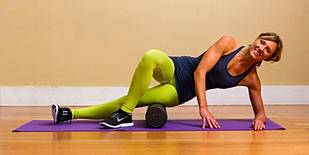Most people will at one point or another experience knee pain during their life.
For some this pain will subside quickly, however, if you are one of the less lucky ones there are a few important tips that will help you on your road to recovery.
From my experience the most common place to experience knee pain is the anteromedial aspect of the patella, or more simply the inside area of the knee.
There are many things that may be causing your pain and each person is different in what works for them but here are a few of my best methods that have success the majority of the time.
First things first – rest and remove inflammation
The most important rule for any type of rehabilitation is removing the aggravating factors. Make a list of things that you know make your knee pain worse, whether it be running, going up or down stairs, sitting for long periods of time or kneeling on the knee. You must make sure to avoid these things at all cost for a minimum of 5-7 days.
During this time you should be using an ice pack every time that you notice your knee pain.
When using ice always make sure it is covered with a cloth and apply for only 15 minutes at a time.
Secondly – eliminate muscle tightness from surrounding muscles
The most effective way to do this is by having a deep tissue remedial massage in order to lengthen and release the tight muscles in the lower limb. You can assist the lengthening of your muscles by diligently stretching the quads, hip flexors and glutes and by using a foam roller.
I’m sure most of you are aware of what a foam roller looks like and unfortunately the pain it can inflict.
It is important when using the foam roller for knee pain that you roll slowly and all the way from the knee up to the hipbone.
You will need to use the foam roller on the following areas: Quads, Glutes and most importantly the ITB (Iliotibial Band). You should spend a minimum of 2 minutes on each area daily.
Thirdly – corrective exercise
When your pain has subsided and you feel ready to go back to training there are a few things you can do to prevent the knee pain reoccuring.
The most important thing to note when returning to activity is that you should be pain free while doing exercise AND 24 hours after.
Therefore, if you wake the following day and you knee pain has worsened you have done too much too soon.
Ice should again be applied after exercise to reduce the chance of re-inflaming the area.
Make sure that you are using proper technique when running, squatting and lunging to prevent re-injury. The muscle that you should be most aware of is your VMO (Vastus Medialis Oblique). This muscle is on the inside of your thigh and if it is weak can be a factor contributing to your knee pain. Making sure that this muscle is activating during exercise can be down by simply placing two fingers on the area to feel for contraction. You can also slightly turn your foot out when performing lunges and squats to help this muscle activate.
If your pain still persists don’t be alarmed it just means you need a little more treatment to help recover.
A remedial therapist can use a wide range of modalities to help with your recovery including: Trigger point therapy, transverse frictions, dry needling, myofascial release, supportive taping and corrective exercise.
Have you ever experienced knee pain, what did you do to overcome it? Please share in the comments below.
























6:30 pm
4:03 pm
4:06 pm
10:39 pm
-

-
-
caitlinplummer replied
- 30 Apr 2015 , 8:29 pm
Reply10:38 pm
-

-
-
caitlinplummer replied
- 30 Apr 2015 , 8:36 pm
-

-
-
caitlinplummer replied
- 30 Apr 2015 , 8:37 pm
Reply10:14 am
-

-
-
caitlinplummer replied
- 30 Apr 2015 , 8:39 pm
Reply9:57 am
7:59 pm
5:14 pm
-

-
-
caitlinplummer replied
- 16 Mar 2015 , 11:22 pm
Reply4:06 pm
3:40 pm
-

-
-
caitlinplummer replied
- 17 Mar 2015 , 8:50 pm
Reply1:17 pm
12:56 pm
9:22 pm
8:28 pm
-

-
-
caitlinplummer replied
- 17 Mar 2015 , 8:48 pm
Reply8:15 pm
6:58 pm
-

-
-
mom93821 replied
- 15 Mar 2015 , 3:59 pm
Reply5:51 pm
-

-
-
caitlinplummer replied
- 16 Mar 2015 , 11:21 pm
Reply1:33 pm
-

-
-
caitlinplummer replied
- 17 Mar 2015 , 8:52 pm
Reply- 1
- 2
- »
Post a commentTo post a review/comment please join us or login so we can allocate your points.